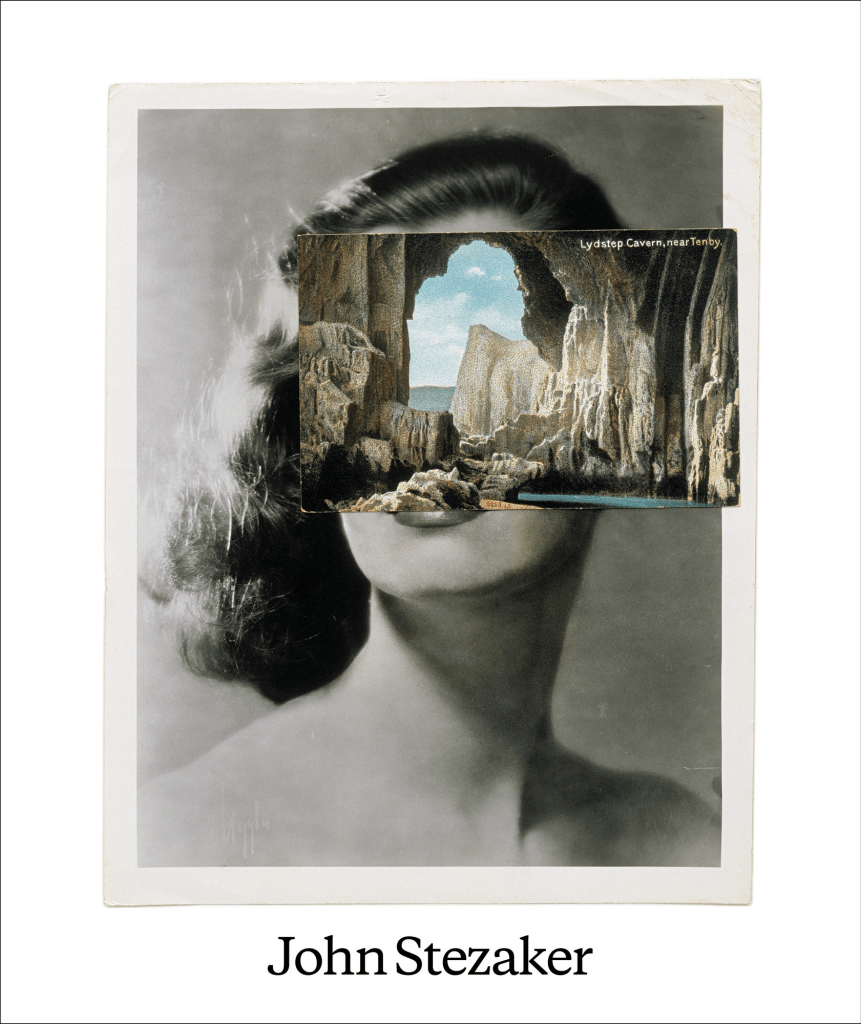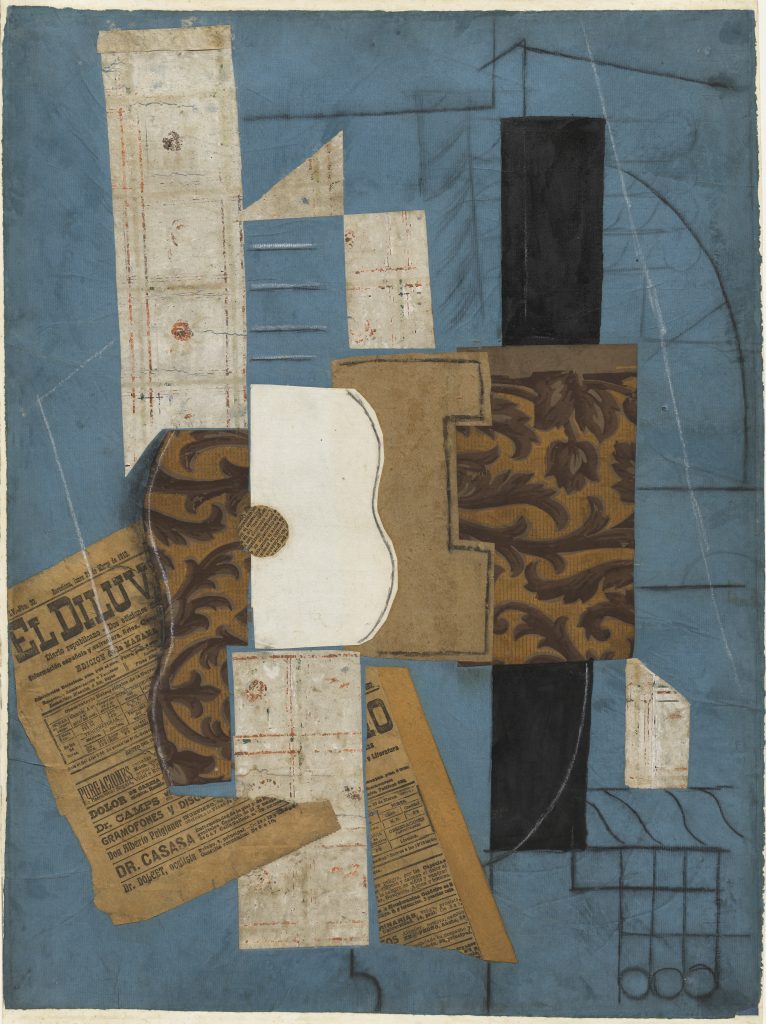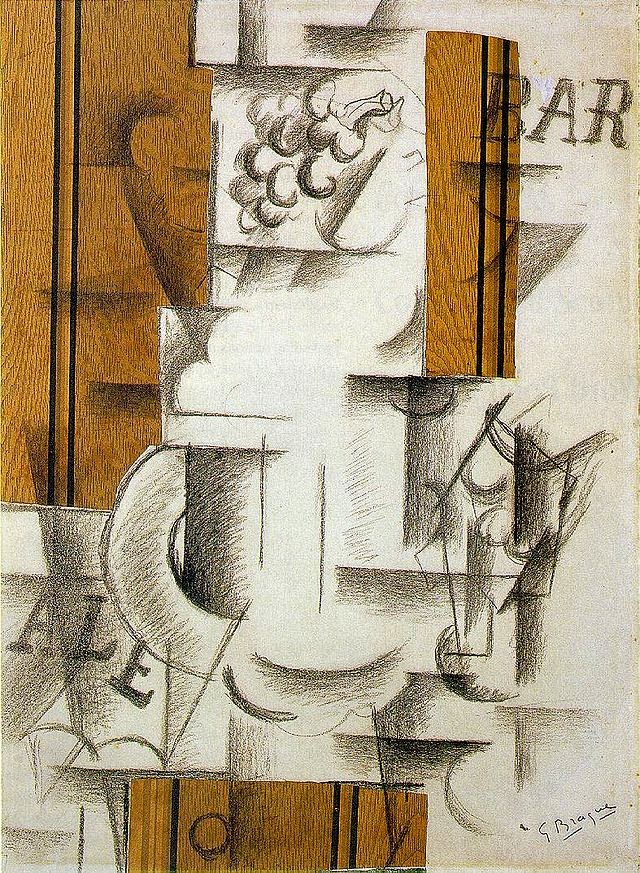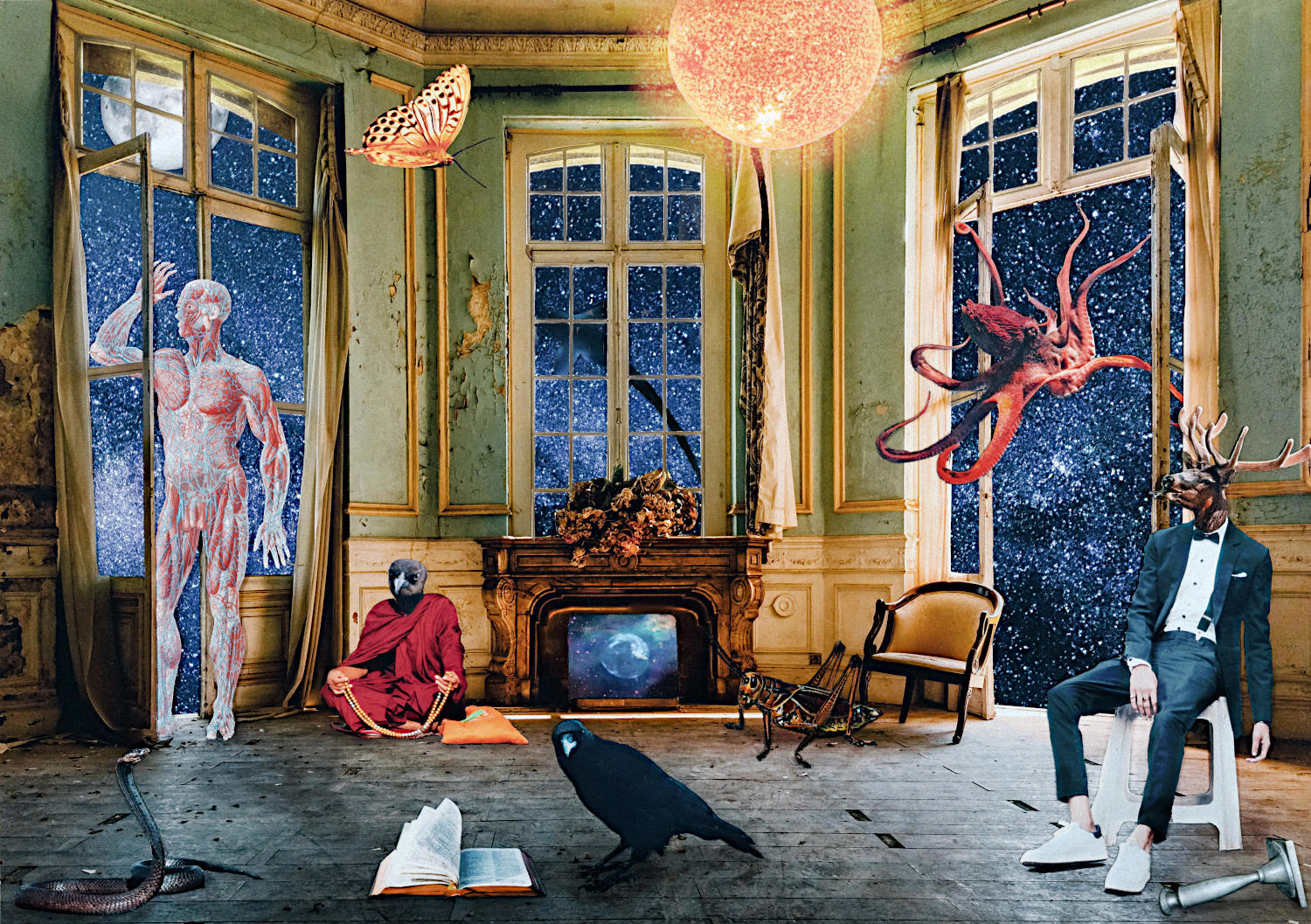Definition and Derivatives of Collage Art
The practice of collage art is a technique of art creation. The word collage is derived from the French coller, “to glue” or “to stick together” It is used in many areas and contexts of the arts including; music, architecture, illustration, artist’s books, literature, fashion design, film and post-production. However, the primary focus of this post is its use in the visual arts. Particularly still imagery. Rather than the incorporation of collage techniques into moving image. I will leave that for another blog post.
Collage art can include an enormous range of materials and techniques. I am sure this is part of its appeal to many artists. These media can include portions of other artwork or texts, elements of drawing and painting, magazine and newspaper clippings, ribbons, paint, bits of coloured or handmade papers, photographs and other found objects, glued to a piece of paper or canvas.
My preference is not to glue the elements down. Because I prefer to photograph the composition when I am happy with it. This way I can alter my compositions as I see fit. Additionally this process enables me to reuse my image resources again and again. In an act of recycling.
Collage Art
“Collage allows the opening up of conscious, which is very direct…its also a way of looking at what you are consuming all the time.”
John Stezaker

Canvas & Wood Collage Art
The painter John Walker is known for using ‘canvas collage’. This is a process of using glue to stick patches of separately painted canvases onto the surface of another or main painting canvas. Thus forming a new work. Kurt Schwitters is credited with pioneering the development of ‘wood collages’ in the 1920’s.
Decoupage
Whilst the craft became known as découpage in France – derived from the verb découper; ‘to cut out’. The most likely origin of this craft is thought to be East Siberian funerary art. These Nomadic tribes would use cut out felts to decorate the tombs of their deceased.
This is the process of placing a picture into / onto an object for the purpose of decoration. Often the images are cut and layered to add depth. Then the result is sealed or varnished for protection. Artist such as Pablo Picasso took decoupage in a more experimental and abstract direction in the early 20th century. Henri Matisse produced one of the most famous decoupage works titled ‘Blue Nude II’.

Photomontage
Much of my work to date can also be included in this category. However I choose to label it collage for simplicity, commonality and the broadly inclusive nature of the term. Also because I may begin to include other elements and media as the work develops. Which is already happening – see the featured image for this post.
So what is photomontage? Well it is a collage art made from photographs. Pieces and elements of several photographs are cut out and reassembled to form a new composition. This composition is then re-photographed to form a seamless photographic print.
An alternative method to this is accomplished with image editing software. This process is also referred to as compositing. The featured image for this post actually combines both of these methods. Because I assembled the image from cut-outs. Then I photographed and finished the piece by including shadows, tidying up cut marks etc. I did this using image editing software.
The Victorian method of ‘combination printing’ as used by Oscar Gustave Reijlander (1857) is also called photomontage. This is because it involved printing from more than one negative onto a single piece of photographic paper.
Despite the perception that digital technology has made compositing easy, much of the work produced is highly involved and rivals the demands of ‘traditional arts’.

Digital collage
This is another application of digital workflow whereby the collage process is done in a way that encourages the chance associations of disparate elements and their transformation to new meanings and suggestions, however subliminal. Another term for collage produced on computer is ‘ecollage’.
Three-dimensional collage
This is the process of assembling items like rocks, beads, buttons, coins, soil etc. This is done in order to form new wholes.
Mosaic
The process of combining small pieces of paper, tile, marble, stone, glass etc. Typically found in spiritual contexts such as; cathedrals, churches and temples. They are combined in such a way as to form a picture. Or patterns in buildings such as Roman villas.
History of Collage Art
Early precedents in Collage Art
The use of collage as a medium can be dated back to the invention of paper in China 200 BC. However its use increased in 10th century Japan. This is when calligraphers began to apply glued paper, using texts on surfaces, when writing their poems.
In Europe its use arose in the 13th century. Then in the 15th and 16th centuries when devotional painted panels which included gold leaf were used in the Gothic cathedrals. Precious stones, and metals were sometimes applied to religious images and icons as well as coats of arms. After this, Hans Christian Andersen used collage in his books produced in the 19th century. Amongst many others.
Cultural institutions have attributed collage as a formal process within the visual arts from 1912. This is due to its adoption by the likes of Picasso and Braque.
However it was used by the Victorians in the 1860’s in the form of photocollage. But many cultural institutions categorise this use as ‘hobbyist’. In response to this it is argued that they were a facilitator of Victorian aristocratic collective portraiture, and proof of female erudition. In addition to this it presented a new mode of artistic representation. Because it questioned the way in which photography is ‘truthful’. It did this by demonstrating an image can be produced beyond the single initial capture of the lens.
Tate & Guggenheim
The Tate gallery state collage “was first used as an artists’ technique in the twentieth century”.
In addition to this the Guggenheim Museum roots it in the beginnings of Modernism. Stating that it “entails much more than the idea of gluing something onto something else”. Writing in an essay it also considered; “collage was part of a methodical re-examination of the relation between painting and sculpture”, and these new works “gave each medium some of the characteristics of the other,”.
Some of the elements added to paintings included newspaper clippings referencing external events such as the Balkans war. By including wider references the content of the art was enriched and looked beyond itself.
The Guggenheim Museum essay considered that by “Emphasizing concept and process over end product, collage has brought the incongruous into meaningful congress with the ordinary.” This is an important statement because it references so much of what Modernism triggered in its art and the art that followed. And continues to this day.
Art Movements
Modernism
So as I have referenced in the previous section many ‘authorities’ on art recognise the use of collage as an established medium with the visual arts from beginning of the 20th century and the emergence of ‘Modernism’. Georges Braque and Pablo Picasso coined the term Papier colle at this time. Just as it became a distinctive part of modern art.

Modernist Cubism
The Cubist painter Georges Braque started using it in his charcoal drawings by adding pieces of cut out simulated oak-grain wallpaper. Being the experimenter and appropriator that he was. It is said that when Picasso saw this he began adding elements of collage to his cubist oil paintings.

Future Precedents
Notice the use of cheap, everyday, “non-art” materials, such as newspaper, cardboard, and wallpaper, in these collages. Using these materials subverts the expectation that art is made from archival, specialized materials like oil paint or bronze; it also calls into question the need for an artist to have extreme technical skill; and finally, it begins to blur the lines between high and low art, as well as art and life. These aspects of collage were picked up on and more strongly emphasized by the members of the Dada “anti-art” movement, which including Francis Picabia, Hannah Hoch, Hans Arp, Raoul Hausmann, and many others. (3)
Dada
The Dadaists found the medium ideal to express their ideas too. One of the movements pioneers was the German artist Hannah Höch. Her piece ‘Cut with the Dada Kitchen Knife through the Last Weimar Beer-Belly Cultural Epoch in Germany’ 1919 was collage. Because it was made with an assemblage of pasted papers.

Surrealism
The collective and disparate nature of the method is well suited to surrealism. Because the inclusion of elements from many sources is full of potential for unusual juxtapositions and the exploration of the subconscious.
At the beginnings of the the surrealist movements Marcel Mariën used a technique named ‘etrécissements’. This involved cutting away parts of an image to make a new reading. This is in opposition to the additive method of collage making.
Another alternative collage method employed by the Romanian surrealist Gherasim Luca, is known as ‘Cubomania’. This is when a picture is cut into squares and the squares are then reassembled without regard for the original image. (2)
Abstract Expressionism
Like their paintings, Abstract Expressionists’ collages emphasise colour, composition, and emotion. They did this by using simplified silhouettes, blocks of cut-and-glued colour, and free-floating, painted lines, the artists added (literal) layers of dimensionality to their trade mark aesthetic. (3)
Pop Art
In 1956, the British artist Richard Hamilton is credited with helping establish the Pop Art movement in 1956. This was done with his eye-catching collage, ‘Just what is it that makes today’s homes so different, so appealing?’. Featuring carefully-selected clippings from American magazines, this piece incorporates what are termed pop culture-related motifs. These include “Man, Woman, Food, History, Newspapers, Cinema, Domestic Appliances, Cars, Space, Comics, TV, Telephone, Information.” (3)
In addition to setting the scene for Pop Art subject matter, this piece also inspired other members of the movement to explore collage art. (3)

1956
Contemporary Approaches
The practice of collage is still popular today. Because it can now draw on a hugely diverse history. Both for its inspiration and new directions. It is still a vibrant exciting medium to work in.
Many of these artists still choose the analogue method. This method uses cut out pieces. Which are then arranged into compositions by hand. Whilst others choose digital software tools to collect and compose their creations.
Whilst others, myself included, combine a range of techniques and hybrids, to produce their work. Incorporating analogue and digital methods. As well as combining still and moving imagery. Here are several contemporary collages and collage makers;


Legal Issues
When collage uses existing works, the result is typically named a ‘derivative work’. The collage then has a copyright. This is separate from any copyrights pertaining to the original incorporated works. (5)
Derivative Work
In copyright law, a ‘derivative work’ is an expressive creation that includes major copyrightable elements of an original. Or previously created first work (the ‘underlying work’). The derivative work becomes a second, separate work independent in form from the first. The transformation, modification or adaptation of the work must be substantial. It must bear its author’s personality sufficiently to be original. Then it will be protected by copyright. Generally speaking collage falls into this protection.
Most countries’ legal systems seek to protect both original and derivative works. They grant authors the right to impede or otherwise control their integrity and the author’s commercial interests. Derivative works and their authors benefit in turn from the full protection of copyright. Without prejudicing the rights of the original work’s author.
For copyright protection to attach to a later, allegedly derivative work. It must display some originality of its own. It cannot be a rote, uncreative variation on the earlier, underlying work. The latter work must contain sufficient new expression. Which is over and above that embodied in the earlier work. In order for the latter work to satisfy copyright law’s requirement of originality. (5)
Tools
Analogue
One of the great aspects of collage can be its simplicity. Because you can make it with found and otherwise waste material. In an act of recycling. As the John Stezaker quote at the start of this piece says…”its also a way of looking at what you are consuming all the time.”
This simplicity carries through to the tools you need to make it as well. Typically you can make fantastic collage with just a pair of scissors and some glue or double sided tape. If you want to get more involved with the process then this list should get you started;
- Three different sizes of scissors; small (nail scissors), medium (typical round the house type) large (think wallpaper scissors).
- A metal straight edge (it holds up to sharp blades better).
- Good quality craft knife. Worth the small investment, as you will be using it a lot. Better than a scalpel, because it is more comfortable to hold and apply pressure with for longer period of time. A scalpel is essentially made for cutting flesh, requiring less pressure and less extended use.
- Cutting matt. It will stop you ruining the table top. Also its better than a sheet of cardboard. Because it offers the right amount of resistance to the blade. This makes accurate cutting easier. I use an A3 size. Go for bigger rather than smaller if you can. Otherwise you are constantly running out of space and having to keep repositioning the workpiece.
Digital Tools
Obviously you will need a pc or tablet of some description to run the necessary software. Unless you will be sourcing all your imagery from the web you will need a way of getting imagery onto the computer. This is where a camera or scanner will be useful. The camera will also be handy to document your work and turn it into a seamless print. Especially if you are following the analogue route.
Next you are going to need software to make the collage with. There are a lot of programs our there that will do the job. They range from free, reasonable, expensive, through to – pay us rent forever!
For the scope of this article I am just going to point out three possible options;
- Corel Paint Shop Pro – Windows, Mac
- Adobe Photoshop Elements – Windows, Mac
- Gimp – Windows, Mac. Linux
Personal Preference
You will need to do some research and testing for yourself to see which suits your way of working and level of familiarity / expertise with these types of software. DO NOT be fooled into thinking you have to pay for the program for it to be any use. I use Gimp – which is free and does all or more than you are likely to need. I switched from Adobe products recently. Partly because, I switched to the Linux operating system. Partly because, I do not want to be paying Adobe rent forever, to use their products.
Well that wraps up my overview of collage and its usage through culture and art history. I hope you found it interesting and informative. Thanks for reading. Please visit regularly for new and inspiring content.
So why not take a look at my collage work here?
- en.wikipedia.org/wiki/Collage
- en.wikipedia.org/wiki/Surrealist_techniques#%C3%89tr%C3%A9cissements
- mymodernmet.com/collage-art-collage/2/
- researchpractices.blogspot.com/2014/08/precedents-and-origin-of-collage.html
- en.wikipedia.org/wiki/Derivative_work
